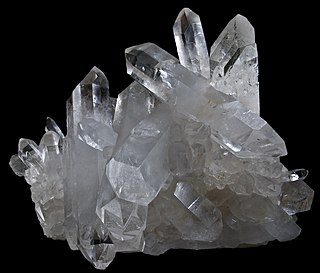
Quartz is a hard, crystalline mineral composed of silica (silicon dioxide). The atoms are linked in a continuous framework of SiO4 silicon–oxygen tetrahedra, with each oxygen being shared between two tetrahedra, giving an overall chemical formula of SiO2. Quartz is the second most abundant mineral in Earth's continental crust, behind feldspar.

Cinnabar, or cinnabarite, is the bright scarlet to brick-red form of mercury(II) sulfide (HgS). It is the most common source ore for refining elemental mercury and is the historic source for the brilliant red or scarlet pigment termed vermilion and associated red mercury pigments.

Benitoite is a rare blue barium titanium cyclosilicate mineral, found in hydrothermally altered serpentinite. It forms in low temperature, high pressure environments typical of subduction zones at convergent plate boundaries. Benitoite fluoresces under short wave ultraviolet light, appearing bright blue to bluish white in color. The more rarely seen clear to white benitoite crystals fluoresce red under long-wave UV light.

Tiemannite is a mineral, mercury selenide, formula HgSe. It occurs in hydrothermal veins associated with other selenides, or other mercury minerals such as cinnabar, and often with calcite. Discovered in 1855 in Germany, it is named after Johann Carl Wilhelm Tiemann (1848–1899).

Livingstonite is a mercury antimony sulfosalt mineral. It occurs in low-temperature hydrothermal veins associated with cinnabar, stibnite, sulfur and gypsum.

Carpathite is a very rare hydrocarbon mineral, consisting of exceptionally pure coronene (C24H12), a polycyclic aromatic hydrocarbon. The name has been spelled karpatite and the mineral was improperly renamed pendletonite.
Lucius Carl Watters was a trumpeter and bandleader of the Yerba Buena Jazz Band. Jazz critic Leonard Feather said, “The Yerba Buena band was perhaps the most vital factor in the reawakening of public interest in traditional jazz on the west coast.”

Corderoite is an extremely rare mercury sulfide chloride mineral with formula Hg3S2Cl2. It crystallizes in the isometric crystal system. It is soft, 1.5 to 2 on the Mohs scale, and varies in color from light gray to black and rarely pink or yellow.

Neptunite is a silicate mineral with the formula KNa2Li(Fe2+, Mn2+)2Ti2Si8O24. With increasing manganese it forms a series with mangan-neptunite. Watatsumiite is the variety with vanadium replacing the titanium in the formula.
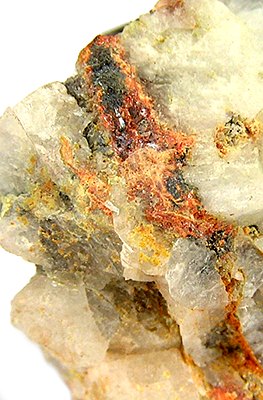
Montroydite is the mineral form of mercury(II) oxide with formula HgO. It is a rare mercury mineral. It was first described for an occurrence in the mercury deposit at Terlingua, Texas and named for Montroyd Sharp who was an owner of the deposit.
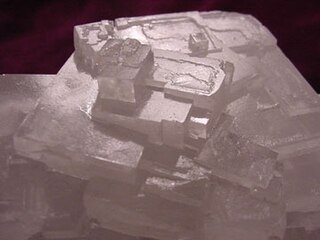
Halide minerals are those minerals with a dominant halide anion. Complex halide minerals may also have polyatomic anions.

Kampfite is a rare barium silicate–carbonate–halide mineral with the chemical formula Ba12(Si11Al5)O31(CO3)8Cl5. Discovered in 1964 and described in 2001, it is named after Anthony R. Kampf. The mineral is known only from Fresno County, California.
Clearcreekite is a carbonate mineral, polymorphous with peterbaylissite. The chemical formula of clearcreekite is Hg1+3CO3(OH)∙2H2O. It has a pale greenish yellow color and streak with tabular subhedral crystals and good cleavage on {001}. It is transparent with vitreous luster and uneven fracture. Its density (calculated from the idealized formula) is 6.96 g/cm3. The mineral is monoclinic with the space group P2/c. Clearcreekite is an extremely rare mineral from the Clear Creek mercury mine, New Idria district, San Benito County, California. It was probably formed after the alteration of other mercury minerals such as cinnabar. The mineral is named after the locality where it was found.

Coloradoite, also known as mercury telluride (HgTe), is a rare telluride ore associated with metallic deposit. Gold usually occurs within tellurides, such as coloradoite, as a high-finess native metal.
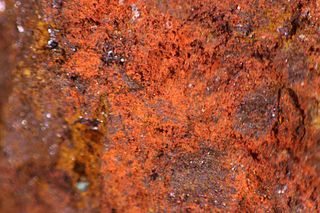
Coccinite is a rare mercury iodide mineral with chemical formula of HgI2, mercury(II) iodide. It was first discovered in Casas Viejas, Mexico; it has also been reported from Broken Hill, New South Wales, and from a uranium mine in Thuringia and old mercury workings in the Rhineland-Palatinate in Germany. At the Thuringia deposit the mineral occurs as a sublimation product resulting from fires associated with pyrite-bearing graptolitic slate.

Fettelite, also known as sanguinite, is a mercury-sulfosalt mineral with the chemical formula Ag16HgAs4S15. The mineral was first described by Wang and Paniagua (1996) who named it after M. Fettel, a German field geologist who collected the first samples from Odenwald. It was first collected in the Nieder-Beerbach mine, 10 km south of Darmstadt, Odenwald, Germany. Its normal occurrence is in hydrothermal veins, which can cut gabbro-diorite intrusives. It is closely related to other rare minerals like dervillite, daomanite, vaughanite and criddleite which are also found in the same type locality as fettelite.

The New Idria Mercury Mine encompasses 8,000 acres of land in the Diablo Mountain range, incorporating the town of Idria in San Benito County, California. Idria, initially named New Idria, is situated at 36°25′01″N120°40′24″W and 2440 feet (680m) above mean sea level. The area was, in the past, recorded in the US Census Bureau as a rural community; however, Idria has become a ghost town since the closing of once lucrative mining operations in the early 1970s.
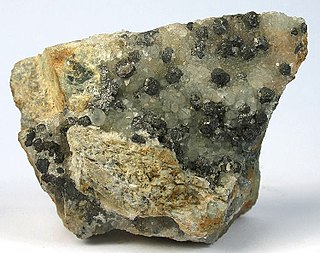
Metacinnabar is the cubic form of mercury sulfide (HgS). It is the high temperature form and trimorphous with cinnabar and the higher temperature hypercinnabar. It occurs with cinnabar in mercury deposits and is associated with native mercury, wurtzite, stibnite, marcasite, realgar, calcite, barite, chalcedony and hydrocarbons.

Karin Aurivillius (1920–1982) was a Swedish chemist and crystallographer at the University of Lund, Sweden. She determined the crystal structures of many mercury compounds.

Edoylerite is a rare mercury containing mineral. Edoylerite was first discovered in 1961 by Edward H. Oyler, whom the mineral is named after, in a meter-sized boulder at the Clear Creek claim in San Benito County, California. The Clear Creek claim is located near the abandoned Clear Creek mercury mine. The material from the boulder underwent several analyses including, X-ray powder diffraction (XRD), a single crystal study, and a preliminary electron microprobe analysis (EMA). Using these analyses it was determined that this was a new mineral but the nature of the material at the time prevented further investigation. It was not until 1986, with the discovery of crystals large enough for a crystal structure determination and a sufficient quantity for a full mineralogical characterization, that the study was renewed. The new edoylerite crystals were found in the same area at the Clear Creek claim but were situated in an outcrop of silica-carbonate rock. This silica-carbonate rock was mineralized by cinnabar following the hydrothermal alteration of the serpentinite in the rock. Edoylerite is a primary alteration product of cinnabar. Though found with cinnabar, the crystals of edoylerite do not typically exceed 0.5mm in length. The ideal chemical formula for edoylerite is Hg32+Cr6+O4S2


















